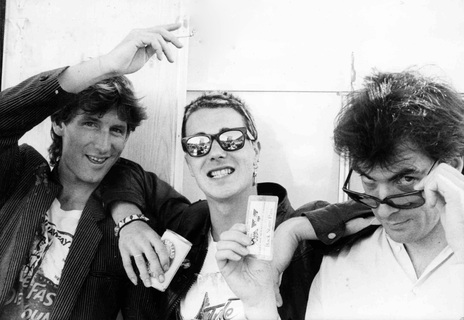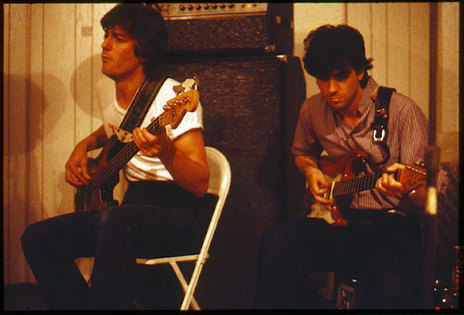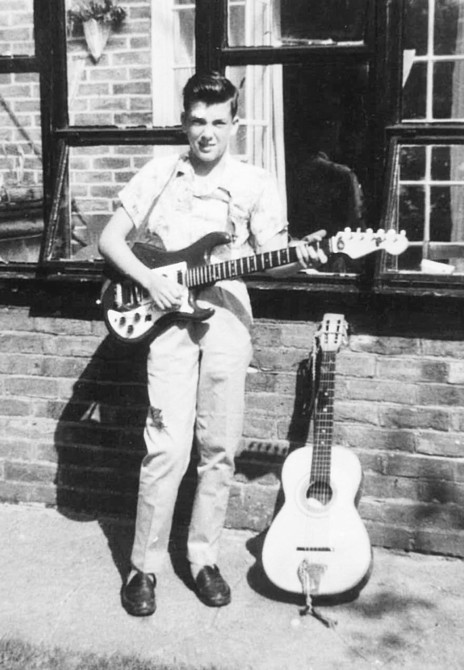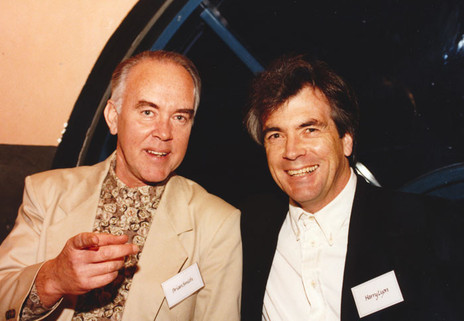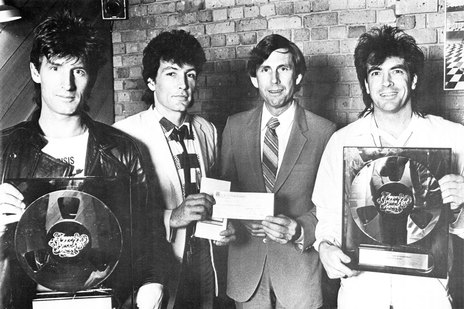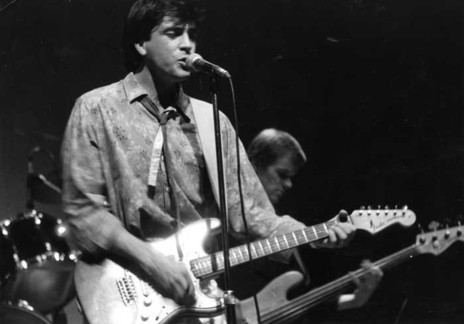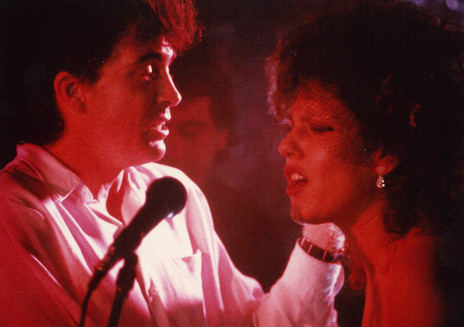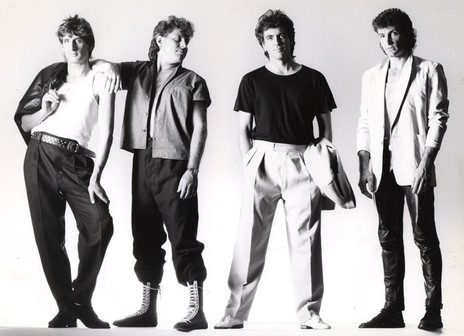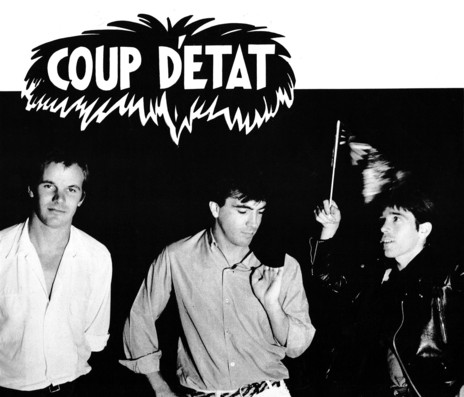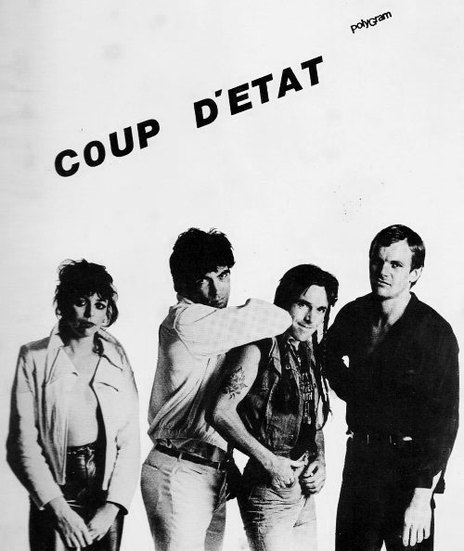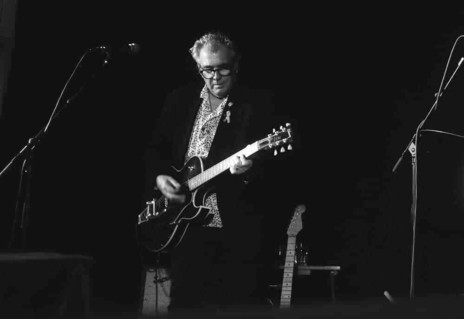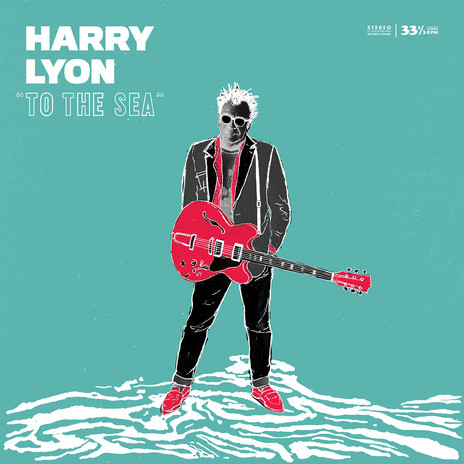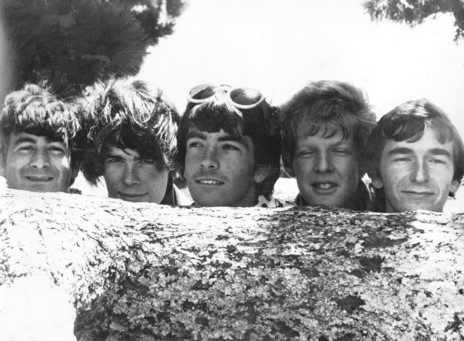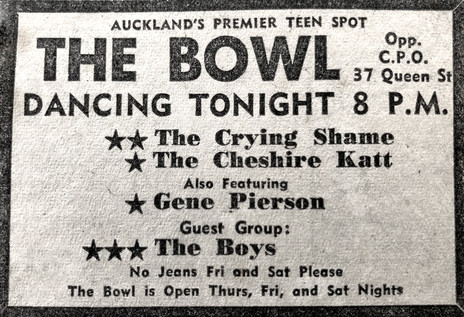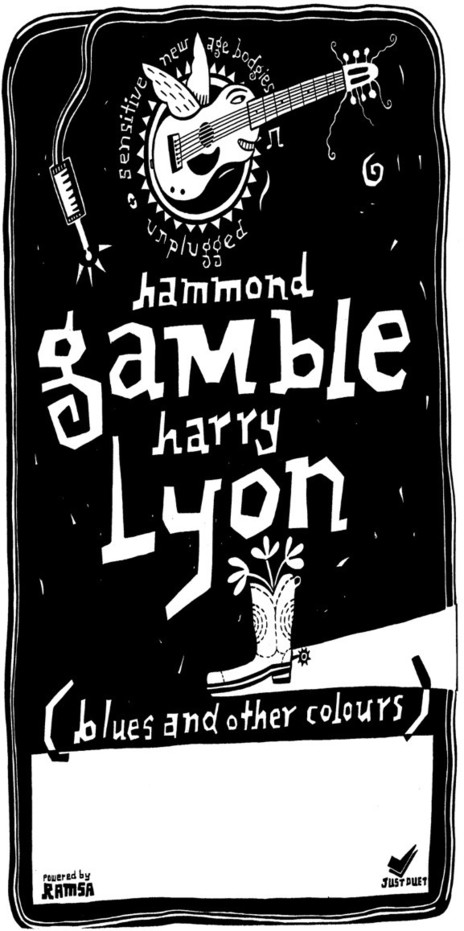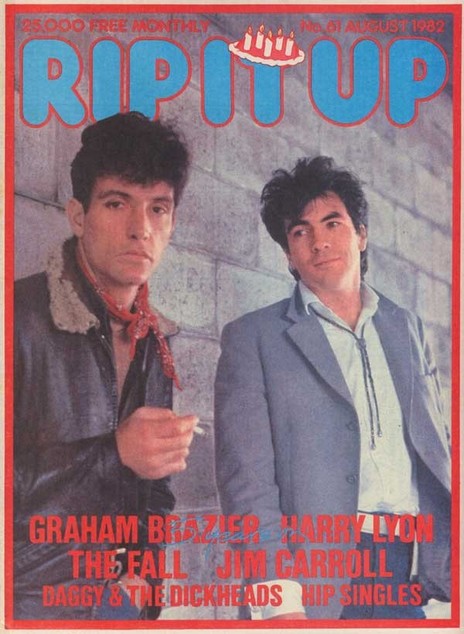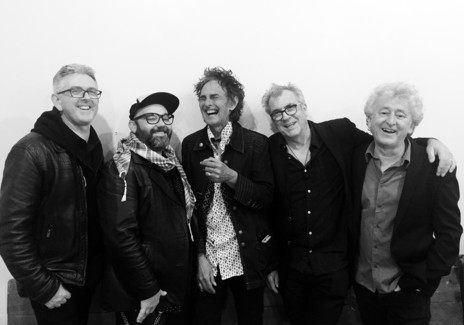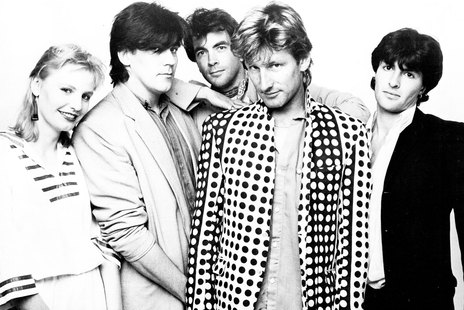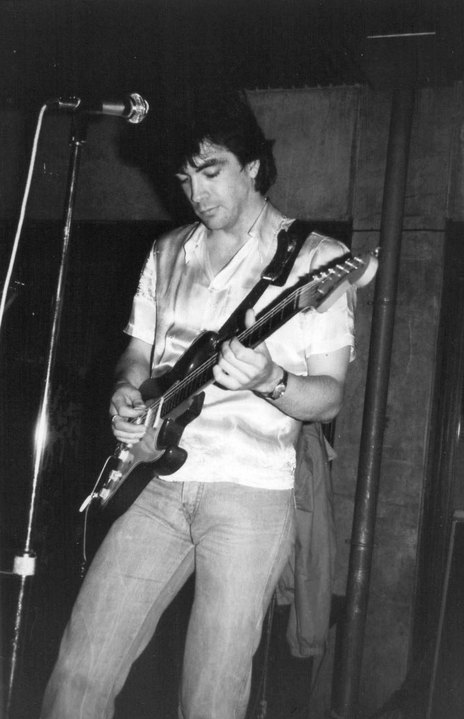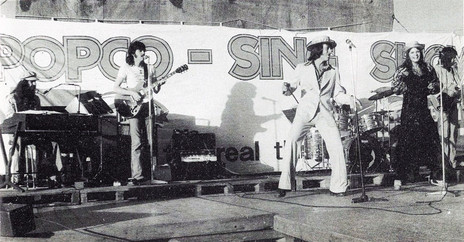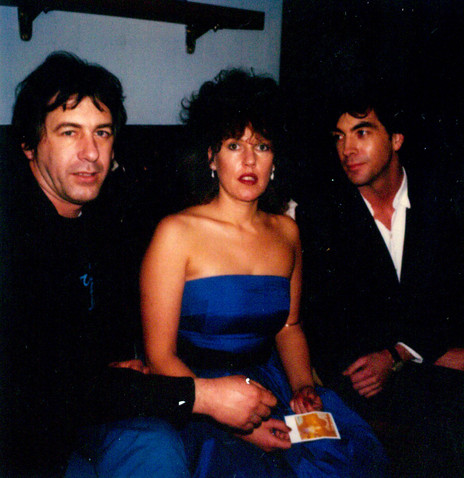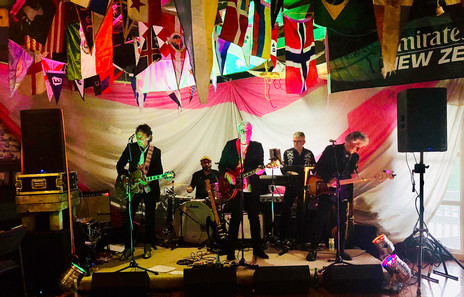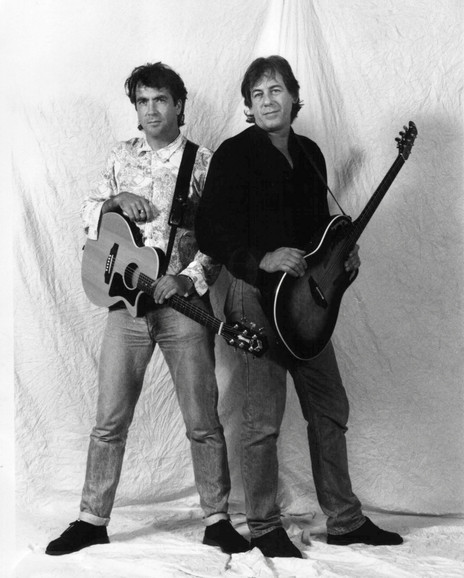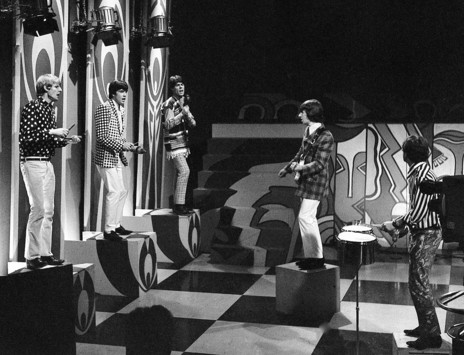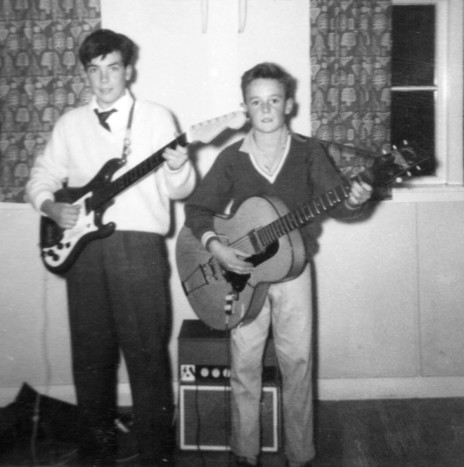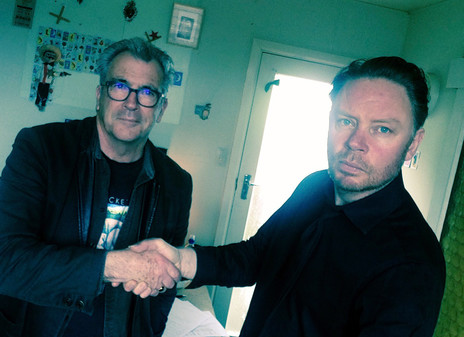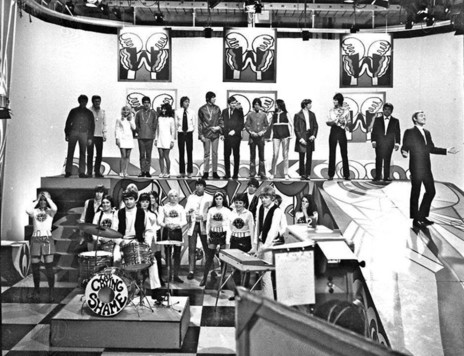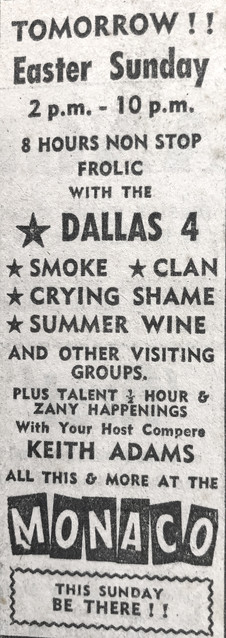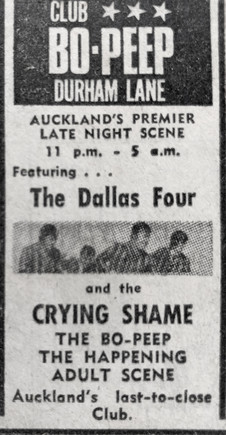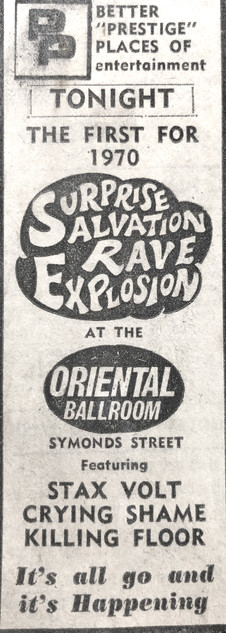Tentatively going out as The Remnants in the immediate years afterwards, Lyon, drummer Rick Ball and long-time bass guitarist Paul Woolright relented to pressure from promoters at the end of 2020 and played to around 50,000 festival punters throughout the country that summer as Hello Sailor.
“Paul and Rick and I just thought, ‘Actually, maybe the time’s right,’” Lyon told AudioCulture. “‘You know, we should do it.’ And it’s good. It feels weird without Dave and Graham, but it’s also very special and we feel them with us through the music.”
It’s also meant Harry Lyon is once again lead singer, just as he was when he joined The Legends on the North Shore back in 1966. But this time it’s his wife Maggy and not his mother who is privy to the full-on vocal practice when there’s work approaching.
“I’ve always been a singer, really. I stopped being a singer in Hello Sailor because Graham was phenomenal and his songs were ‘the voice’ of the band. But most of my life I’ve been the lead singer in the band, so, despite a bit of imposter syndrome, it’s been enjoyable.”
They’ve had to change the key for a couple of songs but this reborn Hello Sailor still deliver the classic repertoire from Brazier’s ‘Blue Lady’, ‘Latin Lover’ and ‘New Tattoo’ to McArtney’s ‘Gutter Black’ and ‘Pink Flamingo’ with Harry Lyon front and centre.
“And, you know, Dave and Graham’s words coming out of my mouth is a special kind of connection that I can have with them, and I know the others feel it too, performing songs we played with them for so long,” he said.
After Hello Sailor’s initial break-up at the start of 1980, Lyon was the first to strike out on his own, in Coup D’Etat. Two years later he was back with the Sailor alumni as part of The Legionnaires, The Pink Flamingos and then again as Hello Sailor. In 2018 he released his solo album To The Sea.
Born on 17 August 1950, Harold Richard Lyon grew up in Milford on the North Shore of Auckland. At the age of nine, he was bowled over upon hearing Elvis Presley while at a teenage party on holiday with family friends at Cornwallis.
“I was introduced to three things that night,” Lyon remembered. “The first was potato crisps, Fanta, and the kid hosting the party with the full-on bodgie kit – brothel creepers, stovepipes, a drape coat with leopard-skin lapels, Brylcreem – and playing Elvis Presley’s ‘One Night With You’. I thought, ‘I wanna look like that and sound like that.’”
Not long after, he first encountered live rock’n’roll. His mother took him to the taping of a radio quiz show at Westlake Girls’ High School where Teddy Couch, playing a black Les Paul, led his band through ‘Great Balls Of Fire’. Then he saw a rock’n’roll band of navy ratings at a ship’s concert at the Devonport Naval Base.
At a party when he was nine, Lyon was introduced to three things: potato crisps, Fanta, and Elvis.
It set a course. Lyon saved his pocket money, bought his own Suzuki No.6 guitar and began lessons in Takapuna. By the time his father’s naval career took the family to England in mid-1961, Lyon could read music notation and play ‘Guitar Boogie Shuffle’.
Spending six months in Plymouth, he came under the tutelage of a young, more hip guitarist who – having discovered Lyon’s skills – revealed the youngster had the ability to play anything he heard on the radio by ear. “And so he set me free,” Lyon said.
When they moved to Emsworth, just east of Portsmouth, Lyon’s teacher was one of big band leader Ted Heath’s bass players. “My deal with him was he would help me learn something I wanted if we spent half the time learning something he wanted. So he taught me to play ‘Rachmaninoff’s Prelude in C# Minor’.”
The family got their first television and Harry Lyon fell under the spell of Shadows guitarist Hank Marvin. He had the sheet music for several of The Shadows’ tunes and his little sister caught him in front of the mirror wearing Groucho Marx glasses from which he’d removed the nose and moustache to look more like Hank.
For his 12th birthday, he received a cherry-red Watkins Rapier guitar and was taken to see Cliff Richard and The Shadows at the Portsmouth Town Hall. In January 1963 he watched on TV as The Beatles performed ‘Please Please Me’ on Thank Your Lucky Stars. “It was like punk, the same sort of impact,” he recalled.
When the family came back to New Zealand later that year, Lyon was armed with the sheet music for several of The Beatles’ early hits. He returned to Milford School, into Form Two, and was one day followed home by a new kid wanting a look at his guitar; one David Ewan McArtney. “I wasn’t that keen, he just followed me.”
The pair bonded and McArtney convinced his parents to buy a drum kit. Lyon and classmate Craig Murray played music together at parties and were soon joined by McArtney and his new acquisition as Lou (Lyon’s school nickname), Craig and Dave, playing mostly Shadows instrumentals. McArtney’s family moved to Wellington in 1964 but the friends continued writing about what they had heard on the radio.
At the age of 15, Lyon answered an ad in the paper for “a guitar player/singer, 17 to 20, for working North Shore band”. He auditioned with The Spencer Davis Group’s ‘Keep On Running’. “Away we went and I sang everything, the lead and the hey-hey-heys. And they said, ‘Okay, that was good, but you don’t have to sing the hey-hey-heys; they’re backing vocals. We’ll do them. Wanna do it again?’”
He got the job and was quickly gigging most weekends as the singer in The Legends, covering the likes of The Kinks and The Who. Guitarist Richard Raven, bass player Mike McGovern and drummer Denis Murphy completed the line-up. During their Saturday night residency at the Surfside Ballroom, the crowd doubled from 500 a night to 1000.
It was at Surfside that Lyon was headhunted by Auckland nightclub band The Crying Shame. Their singing bass player Bob Taylor had left to tour with Le Frame and they were after a new singer. Lyon told them he’d join if he could bring Legends bass player McGovern with him.
“I was a little bit nervous because they were from the other side of the bridge,” Lyon remembered. “They were working even more and were playing in the clubs in the city, whereas The Legends was very much a North Shore band. These guys were playing The Bo Peep, the Galaxie, where The La De Da’s and Larry’s Rebels were big. I said, ‘Well, I’ll come if my mate the bass player can come.’ He was older, a rower and not frightened of anything.”
But McGovern wasn’t involved for long. Taylor returned when he was ousted from Le Frame in favour of Harvey Mann. When guitarist Dave Briscoe stopped coming to rehearsal, Lyon took over on guitar and The Crying Shame became a four piece – Lyon, Taylor, Jim Hoare (guitar/keyboards) and Mick Wills (drums).
At Milford’s Surfside Ballroom Lyon was headhunted by Auckland nightclub band The Crying Shame.
They played at clubs The Bowl, The Bo Peep, Monaco, The Forum and The Oriental Ballroom, and suburban dances in halls and sports clubs such as College Rifles Rugby Club. They appeared on pop TV show C’mon in 1968 and recorded The Rolling Stones’ version of ‘Fortune Teller’ at Eldred Stebbing’s studio, although it was never released.
However, all the gigging was playing havoc with Harry Lyon’s education. “It wasn’t good for the study,” he said. “I did two years in the Sixth Form. But I was working, like, four, five nights a week and making pretty good money too. First year at uni, I failed everything, and so I thought, ‘Maybe it’s time to get stuck in,’ so I did that for a while.”
Still wanting to play, he joined the house band at Romaleigh, a wedding reception lounge in Northcote. The youngest by about 20 years, Lyon thought it would be a doddle but found himself learning all kinds of new chords among the Hal David/Burt Bacharach and Herb Alpert charts.
Dave McArtney had returned to Auckland and he and Lyon moved into a house in Cracroft Street, Parnell, at the end of 1971. They began performing as a duo, mostly at Barry Coburn’s singer-songwriter nights at Levi’s Saloon. “Dave and I started going along to that and playing our erstwhile, heartfelt, hippie, undergraduate kind of songs, and maybe a bit of Neil Young.
“I’d had a reasonably successful year at university and then the next year not quite so. And so we decided, ‘Fuck this, we’ll drop out and start a band.’ I’d say, ‘You’re gonna need an electric guitar.’ And he’d say, ‘Oh, yeah …’ another toke, ‘some of my mates from Wellington wanna go surfing this summer. I might do that too.’ It seemed to take forever.”
Lyon had by this time joined his former Crying Shame bandmate Bob Taylor in a middle-of-the-road pub covers band with drummer Trevor Thwaites and Scottish singer Maurine Mitchell. “She was great and swore she was Lulu’s cousin, so we did lots of Lulu.
“I’d go off playing in the weekends, and when I got home, Dave would have been to the Kiwi [Tavern] or whatever … We’d both arrive home about the same time and compare notes. One time he said, ‘I met this guy Graham Brazier. He’s quite good.’ And he played me ‘Bush By Where You Live’. Dave was intrigued.”
In the meantime, Lyon had hooked up with wife-to-be Maggy and briefly decamped to Dunedin. Back in Auckland he answered another ad in the paper and joined up with organist Don Mills, bassist Tony McMaster and drummer Chris Whitehead in breweries circuit band Beam.
McArtney and Brazier moved into the top floor of Mandrax Mansion in St Mary’s Road; Dragon’s Todd Hunter, Ray Goodwin and Div Vercoe were on the bottom floor. When Beam were in Auckland, Lyon would drop in for what were becoming regular and increasingly popular jam sessions.
Beam had heaps of work, mostly backing TV stars like Angela Ayers, Brent Brodie, Tom Sharplin, Steve Gilpin (later of Mi-Sex), Craig Scott, Claire Raine and Mark Williams. Lyon took the opportunity to meet pub managers and make valuable contacts such as promoters Mike Corless, Bobby Davis and Trevor Spitz.
“Backing all those people meant we were in amongst most of the high-profile Kiwi acts at that time,” Lyon said. “Chris Whitehead had a CF Bedford, so I thought, ‘Great, the essentials. A band on the road, you need a van and you need some gigs. How hard can it be?’”
As Beam came to an end in March 1975, Lyon traded in his Austin A40 Farina for a CF Bedford. Don Mills joined fledgling prog rockers Think, but Lyon held on to Tony McMaster for his next venture. You see, Dave McArtney had finally bought an electric guitar and an amplifier. They recruited drummer Graeme Turner and Hello Sailor was ready to embark on a musical adventure with Graham Brazier as lead singer.
“Palm trees, Hawaiian shirts and ‘British West Ponsonby’ were very much part of the early Sailor schtick.”
The Sailor story has been well documented – the classic line-up of Lyon, McArtney, Brazier, drummer Ricky Ball and bassist Lisle Kinney drawing up the blueprint for touring the country on your own merit, the landmark ‘Gutter Black’ snare sound, the LPs, the six months trying to break the United States and a triumphant return to New Zealand before dissolving in early 1980 after a fruitless crack at Australia.
Lyon’s best-loved contribution from the band’s first chapter was their third single ‘Lyin’ In The Sand’, written while living in the downstairs flat of his wife’s mother’s place. The song spent three weeks at No.29 on the New Zealand charts in April and May 1978.
“I have to give Graham a bit of credit, really. Palm trees, Hawaiian shirts and ‘British West Ponsonby’ were very much part of the early Sailor schtick. Maggy and I were living 50 metres from Takapuna Beach, so in terms of the imagery that’s where a lot of that came from. I was just messing around with that party strum and it’s one of those songs that kind of wrote itself, quite quickly.”
With Sailor’s demise, Lyon was approached by Red Mole’s Jan Preston (vocals/keys) and Neil Hannan (bass) and formed Coup D’Etat. When original drummer Steve Osborne departed, they brought in Paul Dunningham, formerly of Cruise Lane and Brigade.
Coup D’Etat’s self-titled and self-produced 1981 album was preceded by the Lyon-penned Top 10 hit ‘Doctor, I Like Your Medicine’, which was named Best Single at the 1981 NZ Music Awards – one of the few awards not scooped up by Dave McArtney & The Pink Flamingos. Most of Lyon’s five compositions on Coup D’Etat dated back to Hello Sailor’s time in Sydney, although the band never played them.
Preston left at the end of the year, Dunningham joined Mi-Sex in Australia and Coup D’Etat folded in 1982. That May, Harry Lyon reunited with Graham Brazier in The Legionnaires. Three months later, Dave McArtney joined the ranks along with his Pink Flamingos bassist Paul Woolright. Ex-Think drummer Lyn Buchanan completed the line-up, with Stuart Pearce on keyboards a regular addition.
The following year brought the release of The Legionnaires’ Strange Faces At The Oasis single – with Lyon’s ‘You Bring Out The Worst In Me’ on the A-side – a national tour and a Radio With Pictures special and Live At Mainstreet LP, shared with Dance Exponents.
Lyon told Rip It Up in August 1982: “The thing about The Legionnaires, or any band which has a focal point like Graham, is that it has to be his output otherwise it’s awkward for him to stand there and play tambourine while someone else sings. ‘You Bring Out The Worst In Me’ is carefully arranged so it’s more of a duet as far as delivery is concerned.”
The Legionnaires screeched to a halt when Brazier split “to join the Highway 61” halfway through a show at The Gluepot. “Dave said, ‘Oh, well, it looks like we’re the Pink Flamingos,’” Lyon told AudioCulture. “So I became a Pink Flamingo, and we managed to get through the set okay.
“Dave was recording a solo album at Harlequin Studios that was going to be released by CBS. He got me into the studio to record a little bit of guitar and BVs so I had a presence on the album.” Dave McArtney & The Pink Flamingos’ The Catch was released late in 1983. The new-look Pink Flamingos took to the road over the summer before McArtney pulled stumps early in 1984 and turned his hand to producing.
Lyon was managing Harlequin studio when a film producer offered him the lead role in ‘Should I Be Good?’
“The Flamingos thing ended and I did a little bit of work around the house and had a bit of a summer break,” Lyon said. “I’d had a really good run being in bands; everything just sort of fell into my lap. Not saying it wasn’t hard work, we worked hard to get Sailor up and running. There were times it wasn’t easy. But I’d never been without a gig. We had a mortgage and [daughter] Roxy would have been nine or 10. For the first few months of 1984, we were on the bones of our arse at home.”
Harlequin Studios owner Doug Rogers threw Lyon a lifeline. Rogers was heading to the States and asked Lyon if he would be interested in managing Harlequin in his absence. Lyon had just taken on the role when he got a call from movie director Grahame McLean offering him the lead in his movie Should I Be Good?, named after the Hammond Gamble song and based loosely around the then recent Mr Asia goings-on.
“The movie offer was very attractive to me,” Lyon said. “I spoke to Doug and said, ‘I really need the money.’ There was quite a comprehensive soundtrack and they were planning to record it at Mandrill. He said, ‘If you can pull that down to Harlequin, go with my blessing.’”
Shot in Wellington, Auckland, Hong Kong and Bangkok, and also starring Auckland musicians Hammond Gamble and Beaver, Should I Be Good? hit theatres in 1985, by which time Lyon had settled in at Harlequin.
Meanwhile, the classic Hello Sailor line-up had reconvened that February to farewell the Gluepot before renovations. They recorded and released a new song, ‘Fugitive For Love’, and promoted it with a sell-out tour in April before signing to Doug Rogers’ Zulu label. They were to deliver three albums over three years, recorded at Rogers’ Harlequin Studios and financed by an investment partnership with Spinifex.
The experience was not an entirely happy one for Hello Sailor. Young English producer Liam Henshall and others insisted they re-record a chunk of their back catalogue, including Lyon’s ‘You Bring Out The Worst In Me’, with an eye to the British and American markets. Henshall then fired their warhorse bass guitarist Lisle Kinney.
As it turned out, Shipshape & Bristol Fashion, released in 1986, would be their only Zulu LP. Awash with Fairlight synthesiser and not typical of the band’s trademark guitar-driven sound, it was not well received, and after a national tour Sailor was put back on ice.
Taking advantage of his position at Harlequin, Lyon cranked up his jingle writing. He joined pub band GM & The Cyclones fronted by Ngāti Porou soul singer George Munro along with ex-Coup D’Etat drummer Paul Dunningham, bassist Daryn Karaitiana, keyboardist Campbell Hapi, and later Dave McArtney and Tony McMaster.
In the late 80s Lyon began working as a duo with Dave McArtney, and then, in the 90s, Hammond Gamble.
When that ran its course, Lyon and McArtney took up again as a duo, working six nights a week at the likes of the Gluepot Corner Bar and the Masonic Tavern in Devonport, with occasional mini tours around the country. McArtney moved to London at the end of summer 1991 and Lyon asked old friend Hammond Gamble to join him.
“I was thinking about someone to replace Dave, and of course I’d known Hammond forever,” Lyon said. “Hammond says I asked him to audition. But we just invited him and Susan over for dinner because we’d never played together, really. So I said, you know, ‘Let’s just try a few things.’ I think for most of the 1990s, for both of us, that was our bread-and-butter gig.”
Hello Sailor returned in 1994 to record The Album, produced by Stuart Pearce. The acoustic When Your Lights Are Out followed in 2006 and Surrey Crescent Moon in 2012. They were inducted into the NZ Music Hall of Fame in 2011 and continued touring until the death of Dave McArtney in April 2013.
“When Dave died, Graham in particular was really unsure about what to do,” Lyon said. “And to begin with it just didn’t feel right to use the Sailor name. At his funeral, his brothers and sister got me aside specifically to say, ‘We think Dave would want you to keep the band going.’ So that helped.”
Sailor played a few shows with Lyon’s son Johnny on guitar, but had recruited second guitarist Jimmy Taylor for a planned 40th anniversary tour in late 2015. In July, Graham Brazier suffered a heart attack, followed shortly afterwards by a stroke. He died that September. The Auckland tour date became a tribute show for Brazier with the remaining band members appearing as The Remnants.
From 2000 to 2017, Lyon was employed at the Music and Audio Institute of New Zealand (MAINZ). “I started out as a part-time tutor and a novice teacher in 2000. I went to night school and completed a teaching qualification that year, then embarked on a Masters degree from 2001, finishing that in 2004,” he told Trevor Reekie in a NZ Musician article in 2014. He was the MAINZ dean for around seven years and was on a governance group that developed a new suite of tertiary-level performing arts qualifications for the New Zealand Qualifications Authority.
Spurred on by discussions with old friend Victoria Blood and Native Tongue Music Publishing’s Paul McLaney in 2017, Lyon rounded up his unrecorded songs and set about preparing to record a solo album. He had met Delaney Davidson after his tribute to Graham Brazier at the 2015 APRA Silver Scroll and enlisted him as producer.
“I flew down to Christchurch and spent a couple of days at Delaney’s place in Lyttelton. We called it speed dating. I’d sent him very rough demos that he messed with and changed the grooves. Not to all of it, but quite a few. And he said, ‘What do you think?’ I really liked what he’d done and enjoyed working with him, so we checked our diaries and booked a studio.”
The well was deep. ‘Muscles’ dated back to The Legionnaires and was covered by Midge Marsden on his 1990 Burning Rain album, ‘Baby Don’t Stop’ was from GM & The Cyclones days in the late 1980s, ‘One For The Road’ was done with Hammond Gamble and ‘Missionary’ was offered up unsuccessfully for Hello Sailor’s The Album. ‘Dance Me To Hell And Back’ was written during the sessions as was ‘Harbour Lights’, a co-write with Davidson.
In 2018, Lyon’s first solo album ‘To the Sea’ reached No.1 on the NZ album chart.
Released to good reviews in 2018 and briefly No.1 on the NZ album chart, To The Sea was recorded at The Lab with Lyon, Davidson, Wayne Bell and Mark Hughes as the core band. MAINZ music degree students Zion Faletolu, Quiva Pepine and Hope Tuisaua sang backing vocals on several tracks.
“I used to hear them rehearsing harmony parts a cappella near my office at MAINZ,” Lyon said. “I loved the sound and their attention to detail so asked them to be involved. It means a little bit of my MAINZ experience is immortalised musically too, and I like that.”
The album also featured contributions from Hammond Gamble, Midge Marsden, Rick Ball, Paul Woolright, Stuart Pearce, Neil Watson, Kingsley Melhuish and Lyon’s son Johnny, who also took care of the cover artwork and design.
Lyon toured the album with a band made up of Narcs bassist Tony Waine, drummer Josh Sorenson, keyboardist Stephen Small and latter-day Sailor recruit Jimmy Taylor. He also played a few solo shows, most notably as support for America on their New Zealand tour.
These days Harry Lyon is champing at the bit to get back out to the festivals as singer for Hello Sailor. “I’ve worked hard to get my voice back in shape and now I really enjoy singing again,” he said.
“There are some naysayers out there; the odd Facebook comment, you know, ‘There’s no Hello Sailor without Brazier.’ But generally the feedback from our music mates, promoters and the public has been overwhelmingly positive. Nobody misses Dave and Graham more than we do, and flying the Sailor flag connects us to them in a very special way that helps keep their memory and music alive.”
